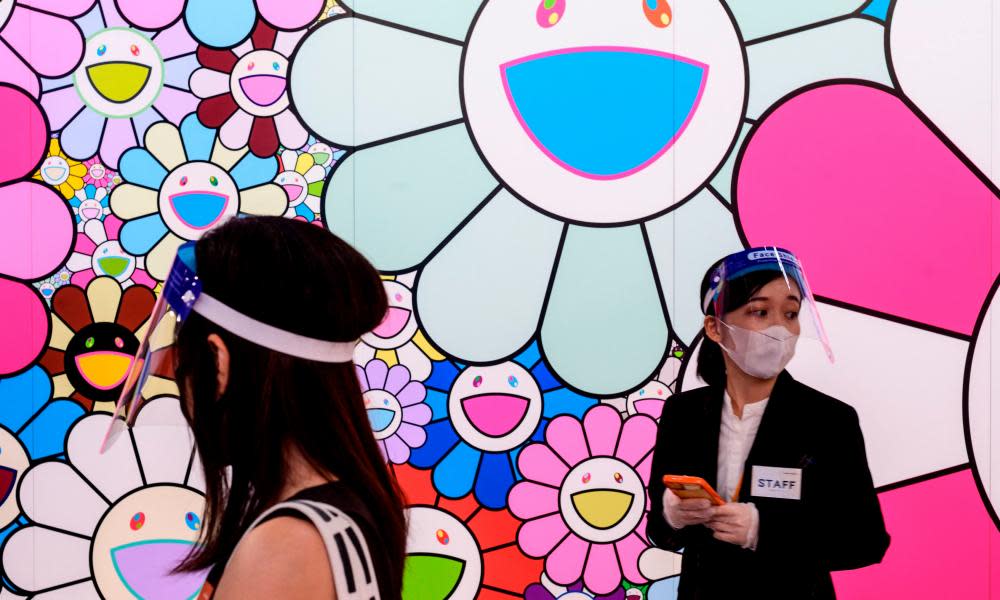You’re already wearing a mask – now consider a face shield and goggles

At first, wearing a face mask felt a bit strange. Now, over five months into North America’s battle with Covid-19, I feel naked in public without one. Will goggles – previously the purview of steampunks and snowboarders – become the next article of protective equipment to go from weird to widespread? According to Dr Anthony Fauci, the answer is yes. In an ABC News Instagram Live Q&A this Wednesday, Fauci told viewers: “If you have goggles or an eye shield, you should use it.”
Related: I'm a viral immunologist. Here's what antibody tests for Covid-19 tell us
On Thursday, Dr Deborah Birx, the White House coronavirus response coordinator, echoed Facui’s statement during a Fox & Friends interview, saying eye protection decreases “the ability for [wearers] to touch their eyes and spread the virus as well as those droplets coming towards them.”
Like your nose and mouth, your eyes are “mucosal surfaces” – permeable areas of the body that are vulnerable to infection. Research from Johns Hopkins University has found that Covid-19 specifically can be contracted via the eyes, “through exposure to aerosolized droplets or hand-eye contact”. However, the virus does not appear to spread through tears or ocular tissue, meaning goggles protect their wearer, not the people around them (you still need a mask for that).
Neither Fauci nor the CDC has officially recommended protective eyewear for the general public yet. However, goggles or face shields, in addition to masks, are required gear for medical patients being treated for Covid-19, and the healthcare personnel working with them. It follows that if you want to err on the side of caution and achieve what Fauci calls “perfect protection” – the covering of all your mucosal surfaces in public spaces – you need to shield your peepers (and no, regular contact lenses and glasses don’t work – I checked).
Wearing goggles to the grocery store may seem extreme, but choosing to do so ultimately amounts to investing in a bit of extra prevention
Wearing goggles to the grocery store may seem extreme, but choosing to do so ultimately amounts to investing in a bit of extra prevention during an immensely serious pandemic. After all, the United States has been the country worst-affected by Covid-19, with more than 4.3m diagnosed cases and over 150,000 deaths. In his broadcast, Fauci noted that residents of Ohio, Tennessee, Kentucky and Indiana should be particularly careful, as their states are “starting to show that very subtle increase in percent positives among the total tested, which is a surefire hint that you may be getting into the same sort of trouble with those states that the southern states got into trouble with.”
The question remains – if goggles are useful in the battle against Covid-19, why are we only talking about them now?
According to Dr Warren Dinges, a Seattle-based board-certified physician in internal medicine and infectious diseases, the new emphasis on goggles probably reflects our growing understanding of the role of aerosol particles in Covid-19 transmission. “When something is airborne … little droplets remain in the air longer and you could then walk into a stream of suspended droplets that could then transmit the virus to you,” he says. “And by wearing goggles you would prevent those airborne droplets from landing on your [eye] mucus membranes and causing transmission.
“I think it’s reasonable, certainly if you’re not going to be able to socially distance, to wear goggles of face shields based on the evidence of airborne transmission,” says Dinges, though he has yet to wear them going to the office or grocery store himself.
Fauci mentioned another reason eye protection has yet to become mainstream during his Q&A, saying: “It’s so easy for people just make a cloth mask.” Indeed, while goggles are not especially hard to come by (you can buy them on Amazon) you can’t really whip up a cute pair of them, and they’re just one more thing we’re not accustomed to – yet. Perhaps one day soon, wearing goggles will be second nature. It won’t be weird if everyone’s doing it.

 Yahoo News
Yahoo News 
